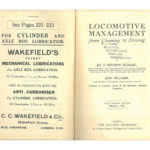Description
Arthur Henry Peppercorn (affectionately known as “Pep”) 1889-1951, was born at Leominster and educated first privately, then at Hereford Cathedral School. He became a Premium apprentice at the Doncaster Locomotive Works of the Great Northern Railway, under H. A. Ivatt in 1905.
Until 1897 the main East Coast Expresses left King’s Cross station behind one of Patrick Stirling’s “Singles”. With its huge high pitched boiler and wide Wooton firebox Ivatt’s Atlantic No. 251 dwarfed the Singles, a comparison well illustrated when a Single (the famous No.1)and an Atlantic, both in immaculate condition, were exhibited side by side at the Shepherd’s Bush exhibition in 1908. (See plate in the Great Northern section of OUR HOME RAILWAYS) Both locomotives were sent south, and maintained for the exhibition, by a young Arthur Peppercorn… In the early 1960s, I was fortunate enough to know Gerry Wintour, himself a former Doncaster apprentice and son of Francis Wintour, sometime Loco Works Manager. Gerry was of course much younger than “Pep”, but spoke very highly of him describing him as rather shy, but always cheerful, with a ruddy complexion and blue eyes.
When Gresley arrived at Doncaster as Carriage and Wagon Supt, in 1905, he became aware during his term of office of Peppercorn as a keen and talented apprentice (the Shepherd’s Bush experience will have helped). On succeeding Ivatt as Chief Mechanical Engineer in 1911, Gresley took a special interest in Peppercorn’s career development, the two became friends, and “Pep” was a popular guest at the Gresley home.
After experience at running sheds, Peppercorn was appointed Assistant to the District Loco. Supt. at Ardsley, followed by promotion to a similar post at the more important Peterborough. During the Great War, he served with the Royal Engineers in France, eventually becoming Technical Assistant to the Chief Mechanical Engineer at the Directorate-General of Transportation.
He returned to the GNR as District Locomotive Superintendent at Retford, subsequently returning to Doncaster as Assistant-in-Charge of the wagon shops. In 1921 he was appointed Assistant to the Carriage & Wagon Superintendent at Doncaster and on the formation of the L.N.E.R. in 1923 became Carriage & Wagon Works Manager at Doncaster. In 1927 he was appointed to a similar post at York. His next appointment, in 1933, was that of Assistant Mechanical Engineer at Stratford, and in 1937 he became Locomotive Running Superintendent of the LNER Southern Area. In 1938 he was promoted to Mechanical Engineer, North Eastern Area based at Darlington.
When Gerry Wintour discovered that I worked on the railway, he asked “Are you On The Square, Old Boy?” Meaning “was I a Freemason?” I answered in the negative.
“My father warned me that I would not progress far if I was not, that is why I left. Be warned, at some point you will find a hopeless member of the Brotherhood promoted over your head, like that (expletive deleted) Edward Thompson, It is unlikely your new boss will ever be promoted again, you will spend you life propping him up, your own path to promotion blocked, until he dies or retires.”
When Gresley died aged 64 in April1941, Chairman Sir Ronald Matthew’s plans for the succession were frustrated. His intention had been (and apparently Gresley was in agreement) that Sir Nigel would continue until age 70, Thompson would retire at 65, and Peppercorn would succeed HNG. Freddie Harrison was earmarked to follow “Pep” in due course.
There was no designated deputy, or assistant to Gresley. Despite both being senior Freemasons, and Thompson, following the death of his wife being a frequent house guest of the Matthews family (the children called him “Uncle Ned”) Matthews was uneasy about Thompson getting the top job, despite being the senior of the. Area Mechanical Engineers. Perhaps he was aware that Thompson was deficient in what would nowadays be called “People Skills?” However, Thompson had supporters among the former North Eastern Directors on the LNER board and if he were to be passed over, it would have to be in favour of an outside candidate.
Sir Ronald first approached Chairman of the Southern Raiway, Robert Holland Martin, to see if Oliver Bulleid, who had left the LNER on 1937 (to become CME at Waterloo) could be released, but he was fully committed to developing his revolutionary “Merchant Navy” Pacifics, to say nothing of a considerable burden of munitions work. Matthews next move smacks a little of desperation. He asked if the LMS would release Roland Bond. Bond had never worked for the LNER , or for one of its constituents, but he had created a very favourable impression when interviewed for the post of Superintendent of the joint LNER/LMS Testing Station at Rugby. The construction of this facility had been put on hold for the duration. Bond was now in charge of Crewe Works, with a massive programme of munitions work, and could not be spared either. Thus after an interval of nearly three weeks since the death of HNG, Thompson’s appointment as CME was announced. One can only imagine what effect this delay had on a man of his temperament.
Peppercorn was appointed to the dual post of Assistant Chief Mechanical Engineer of the LNER and Mechanical Engineer, Doncaster. Four years later he relinquished the latter post “to give closer assistance to Edward Thompson.”
“Use of Coal, Water and Steam in the Locomotive” is very well written, explaining in clear terms the chemical and physical processes taking place in the combustion of coal, the production of steam, and its conversion to kinetic energy. It also shows “Pep´s” affection for the steam locomotive. “It is hoped that the chapters may be of special us to those whose job it is to manage ‘a reservoir of steam power’ which large or small, always remains faithful to the sensitive touch of man.”




Reviews
There are no reviews yet.